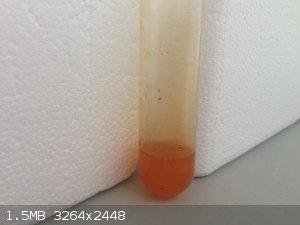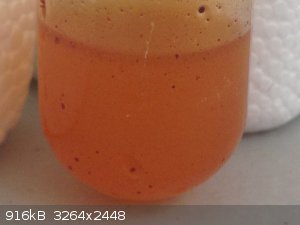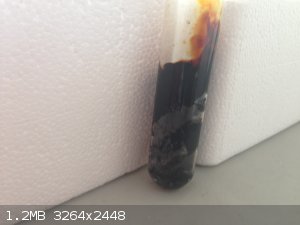Charlemagne
Harmless

Posts: 11
Registered: 30-4-2017
Member Is Offline
Mood: No Mood
|
|
Solvents from the destructive distillation of sugar?
This probably is impossible/uneconomical, but I was wondering if anyone has made solvents or reagents from the destructive distillation of
sugar/starch? I'm guessing that after water, charcoal, and carbon mon/dioxide, the main products would be simple hydrocarbons like methanol, ethanol,
ect, but I wouldn't be surprised if small but potentially recoverable amounts of phenols were produced. The products could then be separated via
distillation, with the water fraction discarded. While the yields would be small for usable products, and probably decreased further by the
distillations required to separate the compounds from each other, sugar is still cheap enough that it might be worth it. I will try to do what I can
to find out what the products are, but I have only recently gotten into amateur chemistry, have no containers larger than 25 milliliters, and the
glass tubing in the setup has a cork for fitting to containers, so I can't reach very high temperatures without charring my equipment. I should be
getting larger containers, an actual condenser, and ground-glass tubing within a few months, but a few months is not today. Still, I will do what I
can, and report the results in the comments. If anyone with good equipment and more experience is interested, please share what you have found below.
|
|
|
clearly_not_atara
International Hazard
    
Posts: 2692
Registered: 3-11-2013
Member Is Offline
Mood: Big
|
|
If you could pyrolyse sugar to make ethanol it'd be a big deal. As of today the only things you can make are furan derivatives and they all require
hydrogenation in addition to dehydration.
|
|
|
hyfalcon
International Hazard
    
Posts: 1003
Registered: 29-3-2012
Member Is Offline
Mood: No Mood
|
|
Dextrin is made by roasting corn startch, but 450-500F is all that's needed.
|
|
|
Charlemagne
Harmless

Posts: 11
Registered: 30-4-2017
Member Is Offline
Mood: No Mood
|
|
This is probably obvious, but this would be for getting solvents more easily for amateurs like myself and most of the other users here, not
industrially. I was actually thinking of putting this in the reagent acquisition forum, but decided to put it here.
|
|
|
unionised
International Hazard
    
Posts: 5102
Registered: 1-11-2003
Location: UK
Member Is Offline
Mood: No Mood
|
|
I think the closest you get is the production of furfural.
http://www.orgsyn.org/demo.aspx?prep=cv1p0280
Fermentation gives some more options.
|
|
|
Dr.Bob
International Hazard
    
Posts: 2656
Registered: 26-1-2011
Location: USA - NC
Member Is Offline
Mood: No Mood
|
|
Yes, there are a number of route in the literature for converting sugars to furfural and some related compounds, but a simple destructive distillation
will mostly make caramel and char. There are a number of companies trying to use biochemistry to convert sugars to useful chemicals, like n-butanol,
furans, pyrans, and more. But all are complex routes.
If you want to do destructive distillation, wood and coal are great places to start. Most other biomass is tough, most methods use hydrogenation of
some sort to reduce the material into liquid fuels. Good luck.
|
|
|
battoussai114
Hazard to Others
  
Posts: 235
Registered: 18-2-2015
Member Is Offline
Mood: Not bad.... Not bad.
|
|
I agree with Bob, you'll likely only get caramel and char from just doing the destructive distillation of sugar. Could especulate that depending on
the heating conditions the gas stream that you'll get could be usable in some Fischer-Tropsch synthesis, though I would think this kind of process is
out of the realm of amateur experimentation and do not assume what you get will be actual syngas based on what I said, I'm just throwing the idea in
the wind.
IIRC I read about a few different catalytic processes that used polyoxometalates in the convertion of biomass to chemicals like EG or acetylene,
that'd be the closest thing I know of that would be in line with what you want without being particularly complex.
Batoussai.
|
|
|
Corrosive Joeseph
National Hazard
   
Posts: 915
Registered: 17-5-2015
Location: The Other Place
Member Is Offline
Mood: Cyclic
|
|
Just ferment it and distill it................ You can thank me later 
/CJ
Being well adjusted to a sick society is no measure of one's mental health
|
|
|
Dr.Bob
International Hazard
    
Posts: 2656
Registered: 26-1-2011
Location: USA - NC
Member Is Offline
Mood: No Mood
|
|
You have to remember that sugars (and most carbohydrates) are essentially the formula CnH2nOn, which when heated can easily go to C6 + n H2O, so if
you heat sugar and trap the gases, you will collect mostly water. That is why the energy content of carbohydrates is lower (about half) than
fats/hydrocarbons, they are about 1/2 water by weight. That is why making ethanol from sugars for fuel is a tough entropic battle compared to using
oil, sugars start with a lot of latent water built into their structure, which means yo make a fuel you have to remove a lot of it, which is energy
intensive. This is one reason why using plant oils for fuel (like biodiesel) makes far more sense in both energy creation and economics. We just
need a better oil crop than soybeans if we are to succeed with that strategy in the US.
|
|
|
Charlemagne
Harmless

Posts: 11
Registered: 30-4-2017
Member Is Offline
Mood: No Mood
|
|
It's been a few weeks, but I finally got around to distilling a 50/50 starch/sugar mixture with enough water added to make it pourable. This had
better mechanical properties than sugar or cornstarch alone (less foaming that sugar, better heat transfer than cornstarch) It had a volume of about
10 ml when I started, but it bubbled a ton, easily doubling its volume. Over an hour or two, 3-4 mL of distillate came over. It started out a light
yellow, but gradually became more orange. A ton of smoke started to be produced, as well as some small, insoluble dark red droplets. Eventually,
things stopped coming over, but I could have gone much further with something better than a crappy alcohol burner. I also didn't have a proper
condenser, just a bent piece of glass tubing, so having a liebig condenser, a heating mantle, and bigger glassware would have increased my yield
significantly, especially of the red liquid. I'd like to try and find out what is in this, but as I don't have any good equipment (no scale,
condenser, ph strips, or even flasks), I can't do much. Pics are below.

Distillate

Closeup of distillate. Note dark red droplets.

Waste in starting container.

All of my equipment. Every. Single. Bit. Hopefully, I'll be able to get more in the next few months.
PS:
The char in the beginning container is somewhat hard to clean. I was able to get most of it out by soaking it in boiling water for a few minutes,
then smashing and scraping it with a stir rod, but some is still on the sides and won't come off. Does anyone know of a fairly easy and accessible way
(so not hot piranha) of getting this last bit of charcoal off?
|
|
|
Chemetix
Hazard to Others
  
Posts: 375
Registered: 23-9-2016
Location: Oztrayleeyah
Member Is Offline
Mood: Wavering between lucidity and madness
|
|
Dry HCl gas in contact with starch and sugars should depolymerise and give you furans and some stable ethers. keeping the HCl in contact with the
sugar with heating needs some technology. Like a stainless steel pipe capped and with a valve. The pressure shouldn't be too high, just enclosed to
keep the HCl in there.
|
|
|
clearly_not_atara
International Hazard
    
Posts: 2692
Registered: 3-11-2013
Member Is Offline
Mood: Big
|
|
Apparently Birch reduction of 2-furoic acid gives the 2,5-dihydrofuran. This can be further reduced to the tetrahydrofuran somehow (?) and distilled
to make THF. Not simple but it's THF which is cool.
Kind of nice since IIRC letting furfural sit around in air will result in mostly 2-furoic acid with a little furyl furoate.
|
|
|
Melgar
Anti-Spam Agent
    
Posts: 2004
Registered: 23-2-2010
Location: Connecticut
Member Is Offline
Mood: Estrified
|
|
Quote: Originally posted by Dr.Bob  | | You have to remember that sugars (and most carbohydrates) are essentially the formula CnH2nOn, which when heated can easily go to C6 + n H2O, so if
you heat sugar and trap the gases, you will collect mostly water. That is why the energy content of carbohydrates is lower (about half) than
fats/hydrocarbons, they are about 1/2 water by weight. That is why making ethanol from sugars for fuel is a tough entropic battle compared to using
oil, sugars start with a lot of latent water built into their structure, which means yo make a fuel you have to remove a lot of it, which is energy
intensive. This is one reason why using plant oils for fuel (like biodiesel) makes far more sense in both energy creation and economics. We just
need a better oil crop than soybeans if we are to succeed with that strategy in the US. |
Interesting fact: carbohydrates were given that name analagous to mineral hydrates, because heating them drove off water, leaving carbon. Since most
of the chemistry back then was related to mining and smelting ore, you can see the traces of inorganic chemistry applied to organic chemistry in its
very beginning, via the etymology.
|
|
|
unionised
International Hazard
    
Posts: 5102
Registered: 1-11-2003
Location: UK
Member Is Offline
Mood: No Mood
|
|
Quote: Originally posted by Chemetix  | | Dry HCl gas in contact with starch and sugars should depolymerise and give you furans and some stable ethers. keeping the HCl in contact with the
sugar with heating needs some technology. Like a stainless steel pipe capped and with a valve. The pressure shouldn't be too high, just enclosed to
keep the HCl in there. |
Not many things rot stainless steel faster than HCl
|
|
|
alking
Hazard to Others
  
Posts: 252
Registered: 11-3-2016
Member Is Offline
Mood: No Mood
|
|
What are you trying to make that you can't more easily purchase? This just doesn't seem practical to me unless you're in an undeveloped part of the
world or something yet have a ton of sugar or similar resources. Even without access to supply houses most joe blows can purchase common laboratory
solvents without issue, if not locally then at least over the internet. Destructive distillation of sugar to get literal milliliters of impure solvent
is just completely impractical when you can buy a liter for 25$ and have it shipped to you in less than a week.
[Edited on 23-5-2017 by alking]
|
|
|
Alice
Hazard to Others
  
Posts: 111
Registered: 11-5-2015
Member Is Offline
Mood: No Mood
|
|
Hydroxymethylfurfural and levulinic acid can be obtained from hexoses upon treatment with an acid.
Biomass pyrolysis is, as far as I know, not utilized/researched to obtain specific chemicals, more for fuel applications, because it gives horrible
mixtures. Maybe one exeption is syngas. Fermentations are much more promissing if the goal is obtaining specific chemicals.
Biomass pyrolysis
[Edited on 24-5-2017 by Alice]
|
|
|
Amos
International Hazard
    
Posts: 1406
Registered: 25-3-2014
Location: Yes
Member Is Offline
Mood: No
|
|
If I decide to try this out on a larger scale with actual glassware, can anyone recommend a cheap and effective way to clean out a bunch of carbonized
sugar?
|
|
|
Melgar
Anti-Spam Agent
    
Posts: 2004
Registered: 23-2-2010
Location: Connecticut
Member Is Offline
Mood: Estrified
|
|
Quote: Originally posted by Amos  | | If I decide to try this out on a larger scale with actual glassware, can anyone recommend a cheap and effective way to clean out a bunch of carbonized
sugar? |
Soak overnight in chlorine bleach. Scrape any large chunks off, if there are any stuck to the side, and repeat as necessary.
Try soaking in water first though, since that will dissolve any sugar still left, loosening some of the carbon.
|
|
|
subskune
Hazard to Self
 
Posts: 71
Registered: 30-4-2017
Member Is Offline
Mood: No Mood
|
|
I have done the pyrolysis experiment with the same idea in mind a few months ago and here are the results - I didn't extract any solvents.
As destillation apperatus I used an old paint can and copper piping with a garden hose for cooling the pipe's surface. Everything was soldered
together and the paint can filled first with starch. This led to very little dark orange distillate with dark red solid droplets inside. It was very
viscous. After only a few mils the destillation stopped because the starch had chared at the bottom of the can and created a foam like carbon
structure which did not transfer heat well.
The sugar instead did melt and and did not char that foamy which lead to a complete pyrolysis. The distillate was orange this time without solid stuff
floating around. Both distillates were acidic and did smell sweet. Both did contain water and aldehyde (fehling - test). I did not conduct further
testing nor did any further destillation.
[Edited on 27-5-2017 by subskune]
|
|
|
Texium
Administrator
       
Posts: 4508
Registered: 11-1-2014
Location: Salt Lake City
Member Is Offline
Mood: PhD candidate!
|
|
Quote: Originally posted by Amos  | | If I decide to try this out on a larger scale with actual glassware, can anyone recommend a cheap and effective way to clean out a bunch of carbonized
sugar? |
But like, why would you want to do that?
|
|
|
Texium
|
Thread Moved
27-5-2017 at 16:53 |